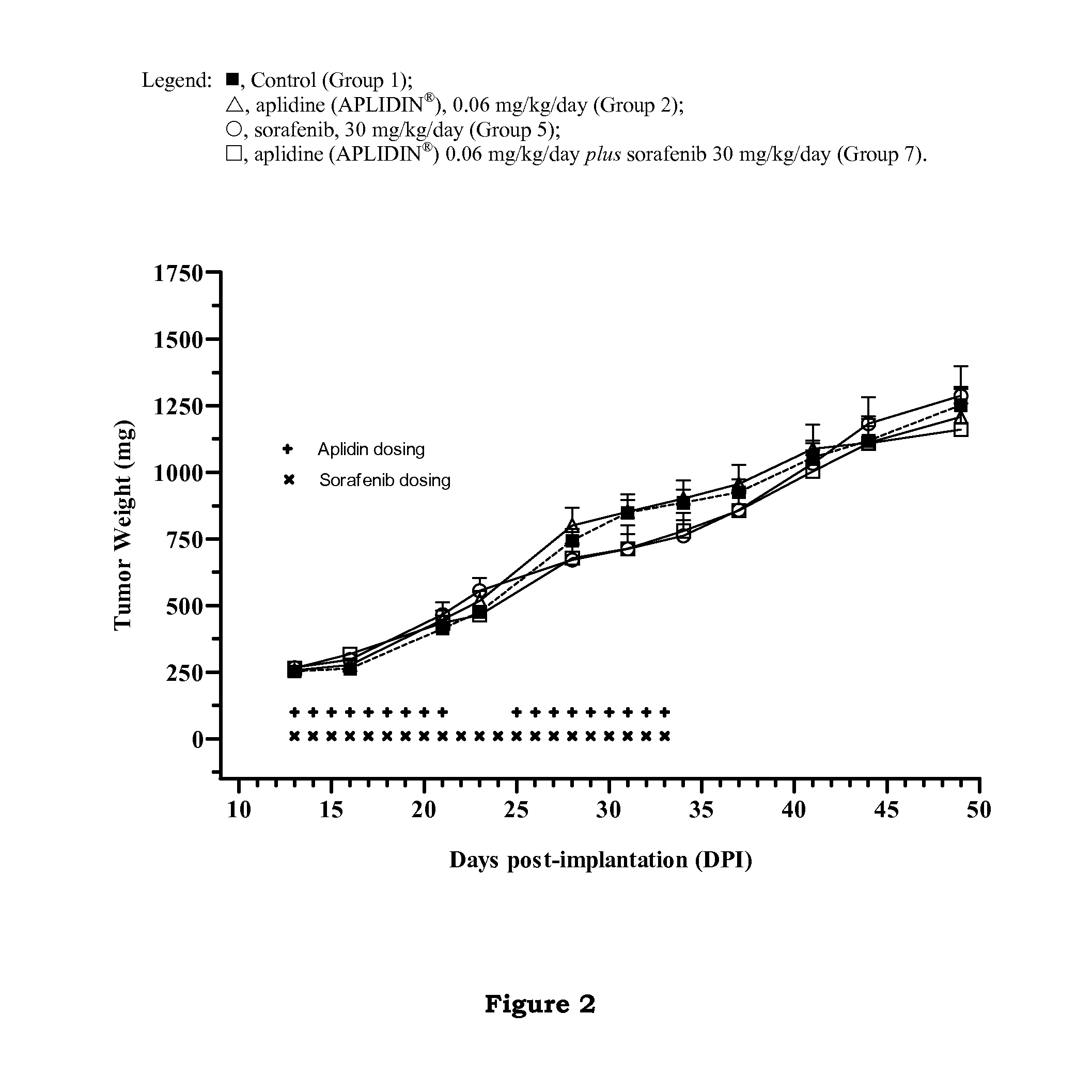Anticancer Treatments
a technology of anticancer treatment and anticancer, applied in the field of aplidine, can solve the problems of ineffective or intolerable, ineffective or inconvenient treatment of many cancer types, and invasive cancer, and achieve the effects of reducing the number of cancer types
- Summary
- Abstract
- Description
- Claims
- Application Information
AI Technical Summary
Benefits of technology
Problems solved by technology
Method used
Image
Examples
example 1
In Vivo Studies to Determine the Effect of Aplidine in Combination with Sorafenib in Human Renal Tumor Xenografts
[0143]The aim of these studies was to evaluate the ability of aplidine to potentiate the antitumoral activity of sorafenib by using three xenograft models of human renal cancer.
[0144]Female athymic nude mice (Harlan Sprague Dawley, Madison, Wis.) were utilized for all experiments. Mice were implanted with tumor fragments or a cell suspension when mice were 5 weeks of age. Animals were housed in ventilated rack caging, 5 mice per cage, with food and water ad libitum. The mice were acclimated for 1 week prior to being implanted with tumor fragments or cell suspensions. The Vehicle Control group contained 15 mice and the treated groups had each 10 mice / group.
[0145]The tumor models used in these studies were CAKI-1 cell line, which is a human kidney clear carcinoma cell line obtained from the ATCC (Manassas, Va.), MRI-H-121 cell line, which is a human kidney carcinoma cell li...
example 2
In Vivo Studies to Determine the Effect of Aplidine in Combination with Sunitinib in Human Renal Tumor Xenografts
[0189]The aim of these studies was to evaluate the ability of aplidine to potentiate the antitumoral activity of sunitinib by using three xenograft models of human renal cancer.
[0190]Female athymic nude mice (Harlan Sprague Dawley, Madison, Wis.) were utilized for all experiments. Mice were implanted with tumor fragments or a cell suspension when mice were 5 weeks of age. Animals were housed in ventilated rack caging, 5 mice per cage, with food and water ad libitum. The mice were acclimated for 1 week prior to being implanted with tumor fragments or cell suspensions. The Vehicle Control group contained 15 mice and the treated groups had each 10 mice / group.
[0191]The tumor models used in these studies were the same as in Example 1 (CAKI-1, MRI-H-121, and A498 cell lines). MRI-H-121 and A498 tumor models were implanted in the animals as disclosed in Example 1.
[0192]CAKI-1 ce...
example 3
In Vivo Study to Determine the Effect of Aplidine in Combination with Temsirolimus in a Human Renal Tumor Xenograft
[0222]The aim of this study was to evaluate the ability of aplidine to potentiate the antitumoral activity of temsirolimus by using a xenograft model of human renal cancer.
[0223]Female athymic nude mice (Harlan Sprague Dawley, Madison, Wis.) were utilized for all experiments. Mice were implanted with tumor fragments when mice were 5 weeks of age. Animals were housed in ventilated rack caging, 5 mice per cage, with food and water ad libitum. The mice were acclimated for 1 week prior to being implanted with tumor fragments. The Vehicle Control group contained 15 mice and the treated groups had each 10 mice / group.
[0224]The tumor model used in this study was MRI-H-121 cell line, which is a human kidney carcinoma cell line originally obtained from the DCT Tumor Bank. For MRI-H-121 assay, animals were implanted subcutaneously (SC) on the right flank, using a trocar, with 3 mm...
PUM
| Property | Measurement | Unit |
|---|---|---|
| time | aaaaa | aaaaa |
| time | aaaaa | aaaaa |
| weight | aaaaa | aaaaa |
Abstract
Description
Claims
Application Information
 Login to View More
Login to View More - R&D
- Intellectual Property
- Life Sciences
- Materials
- Tech Scout
- Unparalleled Data Quality
- Higher Quality Content
- 60% Fewer Hallucinations
Browse by: Latest US Patents, China's latest patents, Technical Efficacy Thesaurus, Application Domain, Technology Topic, Popular Technical Reports.
© 2025 PatSnap. All rights reserved.Legal|Privacy policy|Modern Slavery Act Transparency Statement|Sitemap|About US| Contact US: help@patsnap.com



